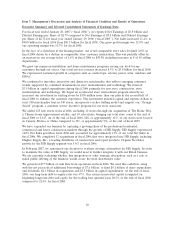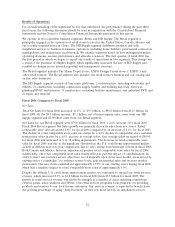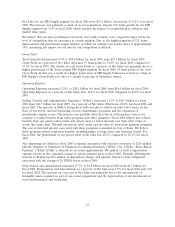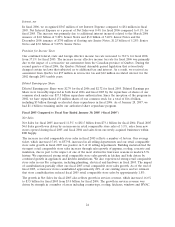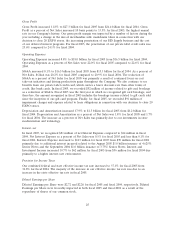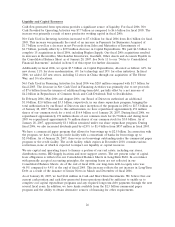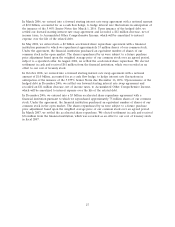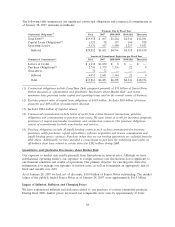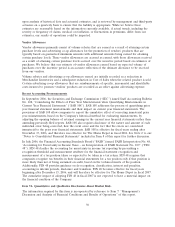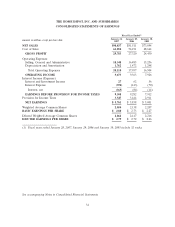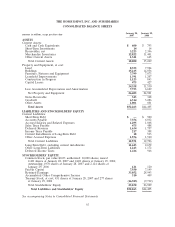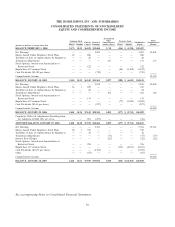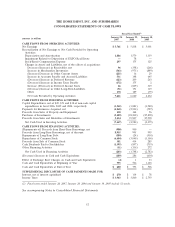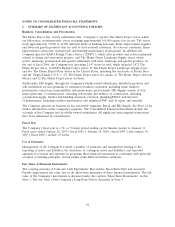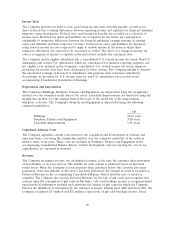Home Depot 2006 Annual Report Download - page 40
Download and view the complete annual report
Please find page 40 of the 2006 Home Depot annual report below. You can navigate through the pages in the report by either clicking on the pages listed below, or by using the keyword search tool below to find specific information within the annual report.
upon analysis of historical data and actuarial estimates, and is reviewed by management and third-party
actuaries on a quarterly basis to ensure that the liability is appropriate. While we believe these
estimates are reasonable based on the information currently available, if actual trends, including the
severity or frequency of claims, medical cost inflation, or fluctuations in premiums, differ from our
estimates, our results of operations could be impacted.
Vendor Allowances
Vendor allowances primarily consist of volume rebates that are earned as a result of attaining certain
purchase levels and advertising co-op allowances for the promotion of vendors’ products that are
typically based on guaranteed minimum amounts with additional amounts being earned for attaining
certain purchase levels. These vendor allowances are accrued as earned, with those allowances received
as a result of attaining certain purchase levels accrued over the incentive period based on estimates of
purchases. We believe that our estimate of vendor allowances earned based on expected volume of
purchases over the incentive period is an accurate reflection of the ultimate allowance to be received
from our vendors.
Volume rebates and advertising co-op allowances earned are initially recorded as a reduction in
Merchandise Inventories and a subsequent reduction in Cost of Sales when the related product is sold.
Certain advertising co-op allowances that are reimbursements of specific, incremental and identifiable
costs incurred to promote vendors’ products are recorded as an offset against advertising expense.
Recent Accounting Pronouncements
In September 2006, the Securities and Exchange Commission (‘‘SEC’’) issued Staff Accounting Bulletin
No. 108, ‘‘Considering the Effects of Prior Year Misstatements when Quantifying Misstatements in
Current Year Financial Statements’’ (‘‘SAB 108’’). SAB 108 addresses the process of quantifying prior
year financial statement misstatements and their impact on current year financial statements. The
provisions of SAB 108 allow companies to report the cumulative effect of correcting immaterial prior
year misstatements, based on the Company’s historical method for evaluating misstatements, by
adjusting the opening balance of retained earnings in the current year financial statements rather than
amending previously filed reports. SAB 108 also requires disclosure of the nature and amount of each
individual error being corrected, how the event arose and the fact that the errors are considered
immaterial to the prior year financial statements. SAB 108 is effective for fiscal years ending after
November 15, 2006, and therefore was effective for The Home Depot in fiscal 2006. See Note 2 to our
‘‘Notes to Consolidated Financial Statements’’ included in Item 8 of this report for further discussion.
In July 2006, the Financial Accounting Standards Board (‘‘FASB’’) issued FASB Interpretation No. 48,
‘‘Accounting for Uncertainty in Income Taxes – an Interpretation of FASB Statement No. 109’’ (‘‘FIN
48’’). FIN 48 clarifies the accounting for uncertainty in income tax reporting by prescribing a
recognition threshold and measurement attribute for the financial statement recognition and
measurement of a tax position taken or expected to be taken in a tax return. FIN 48 requires that
companies recognize tax benefits in their financial statements for a tax position only if that position is
more likely than not of being sustained on audit, based on the technical merits of the position.
Additionally, FIN 48 provides guidance on de-recognition, classification, interest and penalties,
accounting in interim periods, disclosure and transition. FIN 48 becomes effective for fiscal years
beginning after December 15, 2006, and will therefore be effective for The Home Depot in fiscal 2007.
The cumulative impact of adopting FIN 48 in fiscal 2007 is not expected to have a material impact on
the financial condition of the Company.
Item 7A. Quantitative and Qualitative Disclosures About Market Risk.
The information required by this item is incorporated by reference to Item 7. ‘‘Management’s
Discussion and Analysis of Financial Conditions and Results of Operations’’ of this report.
30


